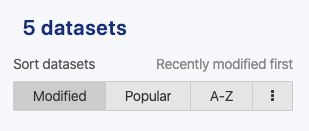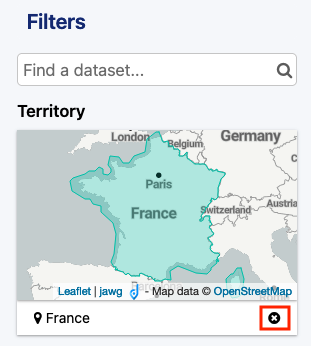Exploring a catalog of datasets
There are several ways to explore a dataset catalog. Whether you are just exploring, or if looking for a specific dataset, here's how to find the data you need.
Sorting the catalog
By default, a catalog is sorted by the date the datasets were modified, with the most recently modified datasets displayed first.
It's possible to change in which order the catalog cards are displayed with the catalog sorting option, found at the top of the sidebar, directly below the number of datasets.
The three most popular methods can be selected by directly clicking on them. Two other methods are available, and all five can be selected in ascending or descending order by clicking the button and selecting your preferred method.
Modified (date the datasets were last modified)
Popular (number of times the dataset has been consulted)
A-Z (alphabetical order)
Number of records (datasets with the most or fewest records)
Number of downloads (datasets with the most or fewest downloads)
Once the new sorting method is chosen, the catalog automatically updates.
Filtering the catalog
When navigating a catalog with only a few datasets, it is easy to scroll down to find the dataset you're looking for. But when navigating catalogs with dozens or even hundreds of datasets, scrolling is impractical. To find specific data, to search for data about a specific topic, time period, or even geographic area, a variety of filtering options are available.
Filters are available below the number of datasets and the catalog sorting option, on the left side of the interface.
It is possible to filter by:
Text, using the search bar
Territory, using the geographic filter
Metadata, using the available filters (View, Publisher, etc.)
Filtering by text (search bar)
To search the catalog by text, the platform will look for a match between your search terms and the metadata for all of the available datasets (the title, description, keywords, etc.).
If there is no match, you will see "Your search didn't match any dataset."
A portal's administrators can see which user searches return no matches. This allows them to better understand what their users are searching for, and hopefully to potentially publish new datasets for those users.
It is possible to make more advanced searches with the search bar, using query language. See Searching the data documentation for more information.
Using the geographic filter (map)
The geographic filter is configured by the administrators of the domain. It is optional, so may not be available in all Opendatasoft domains. The available territories that can be selected with the geographic filter may not be the same from one Opendatasoft domain to another.
If present, the geographic filter—a small map—is under the search bar. When doing a geographic search, the platform will look for a match between the selected territory and the geographic coverage metadata set for all available datasets. Naturally, datasets for which the geographic coverage metadata has not been set cannot be found when using the geographic filter.
To make a geographic search, navigate the available territories until you've reached the one you need. The territories are ordered hierarchically by administrative divisions. Some options are available in the geographic filter to help navigate the administrative divisions:
Back to... allows you to go one step higher in the hierarchy
Go to... allows you to go one step lower in the hierarchy
When more than five territories are available for selection, a search bar is displayed for textual searches in the current administrative division
To deactivate the geographic filter, click on the cross button beneath the map.
Using the selectable metadata filters
Under the geographic filter is a list of selectable filters sorted by category. These should be used to filter the datasets by view (visualizations such as Analyze, Map, Calendar, etc.), date, publisher, keyword, theme, language, and any other available metadata. When searching with the selectable filters, the platform will look for a match between the selected values and the metadata of the available datasets.
To use the selectable filters, click on the value you're interested in. The other values disappear and the catalog directly updates to only display datasets matching the newly applied filter. Some categories allow you to select more than one value. In this case, after clicking on a value, the others do not disappear, and you can click on another value to filter even more.
Some categories, such as "Modification," have values that are sorted in a hierarchical way. For example, the year might need to be selected first, then the months. And once the month is selected, the days are displayed.
Downloading the catalog
Under all the filters are different formats in which you can download the catalog. This does not allow you to download all of the datasets from the catalog (or even the filtered ones), but it allows you to download an index of the datasets from the catalog along with their main metadata.
It is possible to download the catalog in the following formats:
XLSX
CSV
RDF/XML (DCAT)
RSS feed
Using the Opendatasoft Explore API, it is possible to download the catalog in other formats, such as JSON and data.json, but also DCAT-AP (for Flanders, Germany, Italy, Switzerland, Sweden and Spain). Note that if your data include DCAT metadata, you should contact Opendatasoft support to have the relevant export formats enabled on your account.
Exploring a dataset from the catalog
From the catalog interface, only the catalog card of the dataset is displayed.
Note that catalog cards can be customized by portal administrators. Also, if a piece of metadata is not present in the dataset it naturally will not be displayed. However, typically catalog cards contain the following:
A pictogram representing the dataset's theme
The title
A description
The name of the publisher
The dataset's license
The dataset's keywords
Links to the available visualizations of the dataset (e.g. table, map, etc.)
Links to tabs to share or reuse the dataset (e.g. export, API)
Looking at the data
Once you've found the data you're looking for, it's time to have a look at it! To see more of the dataset, either click the catalog card or any of the quick links. See What's in a dataset for more information about the information available there and how to visualize it.
Learn to find datasets, step-by-step
The video at the top of this page is part of an Academy learning path that can guide you through how to find datasets, including using the query language to filter by text in the search bar, step-by-step.





